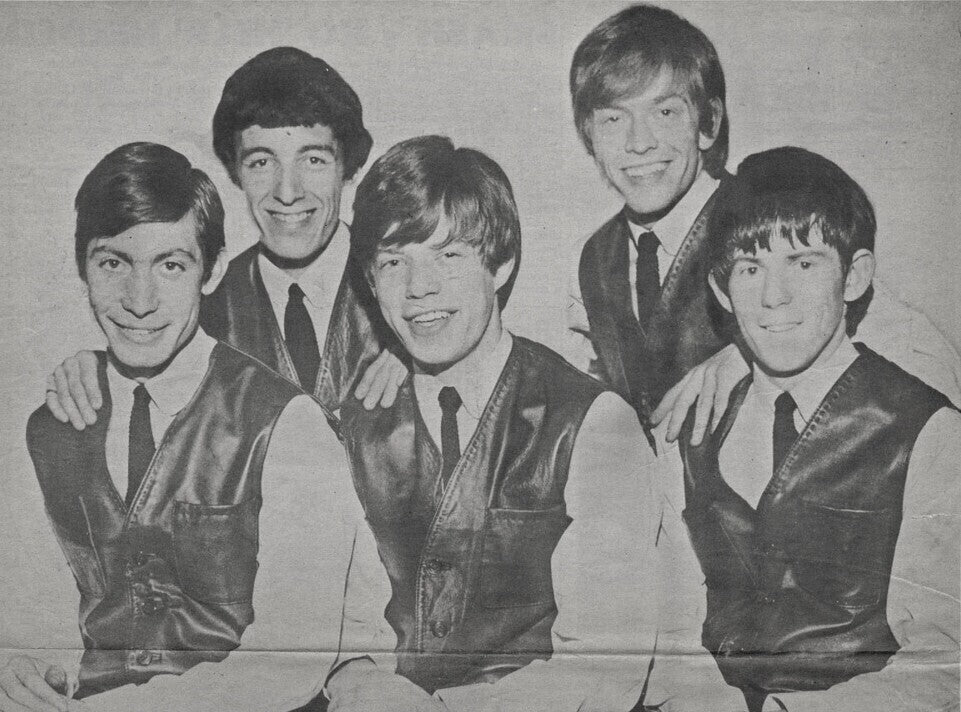Introduction
I decided to construct a playlist of music from the 1930s for my own listening enjoyment. In doing research of leading artists from that decade, I discovered some household names: The McGuire Sisters, Fred Astaire, Gene Autry, Louis Armstrong, the Carter Family, et al. I also came across some pioneering blues artists, most notably Robert Johnson. However, it was this song that was recorded for Paramount Records by Skip James in 1931 that got me thinking about writing this article:
That’s the great Cream song from their 1966 debut album Fresh Cream. It is one of my favorite classic rock songs. I always assumed that it was written by Eric Clapton or Jack Bruce. No, Cream did a very faithful rendition of the Skip James original.
This is the second of two articles that explore classic rock artists from the late 1960s and early 1970s who introduced us to blues music written by others at an earlier time. The first article (in Issue 219) featured the legacy of the Yardbirds and their descendant groups in introducing us to five decades of blues music. Here we start with the Rolling Stones.
The Rolling Stones

The Rolling Stones were at the heart of the British Invasion of the mid-1960s. They are one of the most influential and enduring groups in the history of rock music. Their dedication to earlier blues was apparent early on with renditions of Willie Dixon songs “Little Red Rooster” and “I Just Want to Make Love to You.”
Later in the 1960s, they recorded this song by Reverend Robert Wilkins on their Beggar’s Banquet album. Note that while the Stones’ rendition runs about three minutes, this original goes almost 10:
Reverend Robert Wilkins performed in Memphis and Mississippi in the 1920s and 1930s. In 1936, he witnessed a murder during one of his performances which led to his deciding to dedicate himself to the church. While his first recording of “Prodigal Son” was at the Newport Folk Festival in 1964, it is thought that he wrote the song much earlier.
The legendary Robert Johnson was discussed in the first article of this series. The Stones covered his “Love in Vain” on their Let It Bleed album and “Stop Breaking Down” on Exile On Main Street. Here’s the former:
While available earlier in Great Britain, the Stones’ version of Muddy Waters’ “I Can’t Be Satisfied” was first released in the US in 1972:
Muddy Waters was a renowned singer, songwriter, musician (guitar and harmonica), and bandleader. He was arguably the most important blues artist to emerge after World War II. Waters is in the Blues and Rock and Roll Halls of Fame and was a recipient of the Grammy Lifetime Achievement Award. There is a street in Chicago named after him. Furthermore, the Rolling Stones took their name from a Waters' song, “Rollin’ Stone.” I was very fortunate to have seen him perform several times in the 1960s. Total class act!
John Mayall’s Bluesbreakers with Peter Green

When Eric Clapton left the Bluesbreakers, Peter Green replaced him as lead guitarist and vocalist. Green was an acclaimed young guitarist whose bandmates nicknamed “The Green God.”
Green was with the Bluesbreakers for about a year during which time they produced one album, A Hard Road. The Bluesbreakers’ dedication to earlier blues was by no means diminished here. This album included Elmore James’ “Dust My Blues.” A Hard Road also covered two songs by Freddie King, “Someday After a While” and “The Stumble”:
Freddie King was an acclaimed guitarist, singer, and songwriter. He was a major influence on electric blues guitar. Born in Texas, his style creatively intermixed Texas and Chicago blues influences. King is in the Blues and Rock and Roll Halls of Fame. His bio for the latter indicates that he influenced the likes of Eric Clapton, Jeff Beck, Duane Allman, Keith Richards, and Stevie Ray Vaughan.
Years later, an expanded version of A Hard Road was released. It included “Your Funeral, My Trial” by Sonny Boy Williamson II and J.B. Lenoir’s “Mama Talk to Your Daughter”:
Born in Mississippi, Lenoir moved to Chicago in the 1940s where he became an important member of the Chicago blues scene. A member of the Blues Hall of Fame, he was known for his high pitched voice and theatrical performances highlighted by a zebra-patterned jacket. I originally became aware of Lenoir via a later album by John Mayall, The Turning Point, that included a Mayall song dedicated to Lenoir called “I’m Gonna Fight For You J.B.”
Fleetwood Mac

Peter Green. Courtesy of Wikimedia Commons/Nick Contador.
Peter Green left the Bluesbreakers in 1967 and along with other ex-Bluesbreakers formed Fleetwood Mac. This original Fleetwood Mac band covered a number of earlier blues artists. Robert Johnson rears his head again here with a rendition of “Hellhound On My Trail.” Fleetwood Mac also covered two Elmore James songs, “Got To Move” and “Shake Your Money Maker”:
Elmore James was a guitarist, singer, songwriter, and bandleader. While his career was cut short from heart disease, James found his way into the Rock and Roll Hall of Fame and was an initial inductee into the Blues Hall of Fame when that institution was formed in 1980. He has been called “King of the Slide Guitar.”
Another song covered by Peter Green’s Fleetwood Mac was Howlin’ Wolf’s “No Place to Go”:
Howlin’ Wolf was a blues singer, harmonica player, and guitarist best known for his raspy voice. His career spanned five decades and he is credited with being a major force in evolving delta blues into electric Chicago blues. Wolf is a member of the Blues and Rock and Roll Halls of Fame. I was very fortunate to have seen him perform on several occasions in the 1960s. 60 years later, I still have vivid memories of him crawling on his knees through the audience and howling into the microphone!
Peter Green left Fleetwood Mac in 1970 and the band’s music evolved into a very different sound. Green’s career was somewhat spotty afterward, sometimes interrupted by drug and mental health issues.
The Allman Brothers Band

Based in Macon, Georgia, the Allman Brothers Band is considered to be one of the pioneering bands in southern rock music. Many view them to be the most influential American rock group of the early 1970s. Part of their allure was their dedication to earlier blues music.
One of the Allman Brothers’ signature songs was “Statesboro Blues,” written by Blind Willie McTell:
Born and raised in Georgia, Blind Willie McTell was a singer, songwriter, and guitarist in the Piedmont blues style. He recorded over 120 songs during a career that began in the 1920s. Many artists have covered his songs, including Bob Dylan who also pays tribute to McTell in songs that he wrote. McTell’s Blues Hall of Fame bio calls him “a master bluesman whose recorded legacy has earned him an exalted ranking among the greatest of all time.”
Another earlier blues song recorded by the Allman Brothers was T-Bone Walker’s “Stormy Monday”:
T-Bone Walker transformed early blues guitar into electric music. BB King said, “T-Bone Walker really started me to want to play the blues. I can still hear T-Bone in my mind today from that first record I heard.” Jimi Hendrix was a huge fan and emulated Walker’s stunt of playing guitar with his teeth. Walker was inducted into the Blues and Rock and Roll Halls of Fame. His Rock and Roll Hall of Fame bio describes him as “the godfather of the modern electric blues guitar.”
Most people consider At Fillmore East to be the greatest Allman Brothers album. It is noteworthy that “Statesboro Blues,” “Stormy Monday,” and Elmore James’ “Done Somebody Wrong” are the first three (of a total of seven) songs on that album.
Another earlier blues song recorded by the Allman Brothers was Sonny Boy Williamson II’s “One Way Out” from their Eat a Peach album:
Blues harmonica player, singer, and songwriter Aleck Miller adopted the same name as an earlier blues great and became known as Sonny Boy Williamson II. A number of his songs were mentioned earlier in these articles. He gained fame as a radio personality in the 1940s. Williamson II’s recording career began in the early 1950s and continued until his death in 1965. During his career, he accompanied Robert Johnson, Elmore James, Muddy Waters, the Yardbirds, the Animals, and many others. Williamson was an original inductee into the Blues Hall of Fame.
The Allman Brothers also recorded Muddy Waters’ “Trouble No More” on their debut album in 1969.
Janis Joplin

Janis Joplin. Courtesy of Wikimedia Commons/Grossman Glotzer Management Corporation/public domain.
Janis Joplin left her home in Texas for San Francisco in 1966 to join Big Brother and the Holding Company. They got much acclaim for their performance at the Monterey Pop Festival in 1967. In all, she recorded two albums with Big Brother and the Holding Company before leaving to become a solo artist.
Joplin was a featured performer at the Woodstock Festival in 1969. She produced one album as a solo performer before dying from a heroin overdose in 1970. Another album, Pearl, was released posthumously. Her Rock and Roll Hall of Fame bio calls her “a blues singer of unparalleled passion and the greatest white female performer to emerge from the tempest of the late 1960s.”
Joplin had an affinity for early blues. “Down On Me” is a traditional blues song of unknown origin going back to the 1920s or earlier. The first recording was made by Eddie Head and Family in 1930:
Joplin also recorded “Summertime,” with music by George Gershwin and lyrics by DuBose Heyward. It was written in 1934 for the opera Porgy and Bess.
An iconic Joplin song was Big Mama Thornton’s “Ball and Chain”:
While best known for her rendition of “Hound Dog” which reached Number 1 on the R&B charts, Big Mama Thornton wrote and recorded “Ball and Chain” in 1961. In addition to being a singer and songwriter, she also sometimes played harmonica and drums. Weighing 200 pounds and with a belting voice, she evoked a powerful stage presence. However financial success eluded her and alcohol got the best of her. She died in poverty from heart and liver disorders at age 57. Big Mama was posthumously inducted into the Rock and Roll and Blues Halls of Fame.
Other Artists

The Animals. Courtesy of Wikimedia Commons/Richard William Laws.
To a lesser degree than those artists previously discussed, other classic rock groups were covering earlier blues during the late 1960s and early 1970s. A memorable song by the Doors was Willie Dixon’s “Back Door Man.”
Hailing from Northern Ireland, Van Morrison and Them did a rendition of Big Joe Williams’ “Baby Please Don’t Go.” Williams recorded this song in 1935. It may have been derived from an earlier traditional song. That’s Sonny Boy Williamson I on harmonica:
Williams was a Delta blues vocalist, guitarist, and songwriter noted for playing a nine-string guitar. In his earlier years, he was an itinerant musician traveling from Mississippi throughout the Midwest. In later years, he became a fixture at coffee houses and music festivals and toured Europe and Japan. His Blues Hall of Fame bio describes him as “inimitable” and “irascible.”
Eric Burdon and the Animals’ signature song was “The House of the Rising Sun.” It is derived from a traditional English folksong that was first recorded in the 1930s. Its exact origin is unclear, with some people tracing its roots to the 17th century. The Animals also recorded Ma Rainey’s “See See Rider.” That’s Louis Armstrong accompanying her on the cornet:
Ma Rainey was a blues singer and songwriter whose career began in the 1900s. In the 1920s, she signed with Paramount Records and recorded over 100 songs in a six year period. Rainey adapted “See See Rider” from a traditional song and recorded it in 1924. She was inducted into the Rock and Roll and Blues Halls of Fame and was a recipient of the Grammy Lifetime Achievement Award. Rainey’s Rock and Roll Hall of Fame bio calls her “the unchallenged Queen of the Blues.”
The Grateful Dead recorded renditions of Sonny Boy Williamson I’s “Good Morning Little Schoolgirl” and the Mississippi Sheiks’ “Sitting On Top of the World.” These songs were discussed earlier in these articles.
Conclusion
Blues artists covered in this two-part Blues History By Way of Classic Rock series were:
Skip James
Sonny Boy Williamson I
Howlin’ Wolf
Bo Diddley
Little Walter
Robert Johnson
Otis Rush
Freddie King
Memphis Slim
Willie Dixon
The Mississippi Sheiks
Blind Willie Johnson
Sonny Boy Williamson II
Reverend Robert Wilkins
Muddy Waters
Elmore James
JB Lenoir
Blind Willie McTell
T-Bone Walker
Big Mama Thornton
Ma Rainey
Big Joe Williams
Traditional/unknown origin
The songs described in these articles were written or adapted over a five decade period, starting in the 1920s and through the early 1960s. It should be noted that all the classic rock artists covered in the first article and a majority of those in the second are British. Much thanks to our friends on the other side of the pond for bringing this incredible music to us and helping to keep it alive.
So which blues artist was covered most frequently by the classic rock artists who were the subjects of these articles? It may come as a surprise to many that the “winner” is…Willie Dixon. He was followed closely by Robert Johnson.
Let’s close with one more Dixon song. We began these articles with Skip James’ “I’m So Glad,” a song popularized by Cream. We’ll end with another Cream song, Willie Dixon’s “Spoonful”:
Header image of the Rolling Stones courtesy of Wikimedia Commons/public domain.



